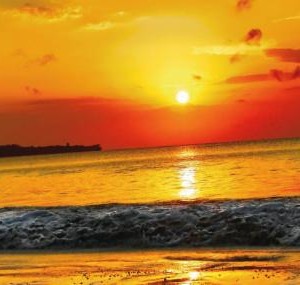- Belgium comes to Yamashita Park
- Residential Villa in Phuket Entices Remote Workers With Long-Stay Rates
- Rare pieces of French glass art at the Mirai Museum of Art
- Feast on fresh fish and seafood at the 2024 ‘Sakana’ Festival
- Would you like to ride in a Louis Vuitton gondola lift?
- Naked Snow Aquarium
- Festive lights at Yomiuriland will get you feeling the holiday vibes
Welcome to paradise: Bali

“Welcome to Paradise,” the sign says as you arrive in Bali.
While the long and sticky wait at immigration—which can be avoided if you fly on Garuda and get your entry papers stamped in flight—proved to be more hellish, the Island of the Gods, as it otherwise claims to be, works hard at living up to its own PR. One of the 5,000 islands that make up Indonesia, the ancient Hindu kingdom of Bali effortlessly balances the modern and the ancient, catering to everyone from hippie trekkers and Aussie surfers to Japanese “princesses” in search of spa heaven.
With kids, you may be tempted to just stick to the beach, but don’t overlook the other option of heading for the hills and the cultural and culinary heart of the island—Ubud.Most of Ubud’s top notch resorts such as the Four Seasons and the Maya Ubud Resort lie a couple of kilometers outside the town proper and are nestled amongst rice paddies and river valleys. A myriad of smaller hotels and hostels are dotted throughout the town and cater for all budgets.
First put on the map by expatriate artists such as Walter Spies and Rudolf Bonnet, Ubud is the artistic capital of Bali. Everyone is an artist—your cab driver, his brother, your waitress’s uncle. Walk or cycle through the surrounding, lush verdant rice fields and you’ll pass open workshops strewn with statues, their indolent carver undoubtedly taking a cigarette break, or painters sitting by completed canvases stacked up in rows. In town, every street has its share of shops, high-end galleries and tourist stands, and in the central market, pictures of every conceivable style and price are stacked next to spices, soaps and sarongs.
At the top end of the scale, and worth a browsing, is the Agung Rai Museum of Art, which features pieces by Spies, owner Agung Rai and other well-known local artists. There are two schools of thought, depending on who is driving you that day—Ubud is a good place to buy good art cheaply, or my friend/uncle has a shop somewhere else that sells gallery-quality pictures for less than the galleries. It is hard to tell who’s right. If cheap and cheerful mass-produced work is what you want, the market is as good a place as any. For high-quality work by better-known artists, you’ll have to pay gallery prices. Of course, like everything else in Bali, from taxi rides to turmeric, the price is always negotiable.The central market and its surrounding streets are the heart and soul of Ubud. Although the market in Denpasar, the island’s true capital, is cheaper for sarongs, the trip there is unnecessary if you are just looking for souvenirs. You will find everything from spices and carved masks, to silver and knock-off Rolexes. Better quality and more upmarket items can be found in the growing number of boutiques springing up around town.
For those who want to take a walk on the wild side, head to the monkey forest where you can explore ruins dotted among the trees and try to stop your camera being swiped by one of the primate inhabitants. Keep a close eye on baseball caps, sunglasses and other easily pilfered items as the residents mean monkey business. A more sedate encounter with the natural world can be had on one of the many treks and cycling tours on offer in the area that take you through the local countryside. If you’d rather someone larger put the effort in, try an elephant trek where Nellie will do all the hard work for you. All types of tours are easily booked through your hotel or direct with tour companies that advertise in the town.
As the culinary center of Bali, restaurants abound. Award-winning Mozaic (Tel. 0361-975768), with its al fresco kitchen and tables dotted around a lush garden, is a standout and is known as the island’s premier dining spot. It is a great place for a romantic dinner a deux sans kids. More casual fare can be had at the excellent Kafe Batan Waru, which features a range of great local and traditional Indonesian dishes.
If you want to dine overlooking ponds and gardens try the well-known Lotus Café. Many of the local restaurants, such as Bumbu Bali 2 (tel: 0361-976698), offer daytime cooking schools, as do many of the hotels such as the Maya Ubud.
After a few days of relaxing at the riverside pool, sampling the local fare, a stroll through the monkey forest and an evening of Legong Dance in the village hall, we felt as if paradise had indeed been found.
Monkey Family in the beautiful Ubud Monkeys Forest, Bali, Indonesia. The Ubud Monkey Forest is a nature reserve and temple complex in Ubud, Bali. It houses approximately 340 Crab-eating Macaque (Macaca fascicularis) monkeys (32 adult males, 19 male sub adult, 77 adult females, 122 juvenile and 54 infants (January 2010).
There are four groups of monkeys each occupying different territories in the park. The Sacred Monkey Forest is a popular tourist attraction in Ubud, and is often visited by over 10,000 tourists a month.
The Monkey Forest contains the Pura Dalem Agung Padangtegal temple as well as a “Holy Spring” bathing temple and another temple used for cremation ceremonies. The Monkey Forest is owned by the village of Padangtegal and village members serve on the Monkey Forest’s governing council. The Padangtegal Wenara Wana Foundation manages the Monkey Forest and serves to maintain its sacred integrity and to promote the sacred.














